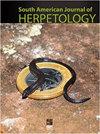欢卡班巴凹陷安第斯蜥蜴一新种的描述与系统发育
IF 0.7
4区 生物学
Q4 ZOOLOGY
引用次数: 4
摘要
摘要根据最近的收集,我们描述了一种来自厄瓜多尔南部和秘鲁北部安第斯高地的巨蜥新种。在其他特征中,该新种与其他种类的Macropholidus的不同之处在于,它有一系列成对的扩大的中背鳞行,仅限于颈背、条纹背鳞,以及尾部、侧翼、肩胛骨区域和颈部的角部。我们还提供了尾龙亚科的分子系统发育和遗传距离,作为支持新物种划界的额外证据,该物种是厄瓜多尔南部M.annectens的姐妹。安第斯造山运动的数据和尾龙类蜥蜴的年龄估计表明,长期以来被认为具有生物地理屏障和迁徙走廊双重作用的环卡班巴凹陷,也是巨蜥起源和多样化的中心。本文章由计算机程序翻译,如有差异,请以英文原文为准。
Description and Phylogeny of a New Species of Andean Lizard (Gymnophthalmidae: Cercosaurinae) from the Huancabamba Depression
Abstract. We describe a new species of Macropholidus lizard from the Andean highlands of southern Ecuador and northern Peru based on recent collections. Among other characters, the new species differs from other species of Macropholidus in having a paired series of enlarged middorsal scale rows restricted to the nape, striated dorsal scales, as well as ocelli on tail, flanks, scapular region and neck. We also present a molecular phylogeny of Cercosaurinae and genetic distances as additional evidence supporting delimitation of the new species, which is sister to M. annectens from southern Ecuador. Data on Andean orogeny and age estimates of cercosaurine lizards suggest that the Huancabamba Depression, long recognized for its dual role as a biogeographic barrier and a migration corridor, has also served as a center of origin and diversification of Macropholidus lizards.
求助全文
通过发布文献求助,成功后即可免费获取论文全文。
去求助
来源期刊
CiteScore
1.50
自引率
0.00%
发文量
10
期刊介绍:
The South American Journal of Herpetology (SAJH) is an international journal published by the Brazilian Society of Herpetology that aims to provide an effective medium of communication for the international herpetological community. SAJH publishes peer-reviewed original contributions on all subjects related to the biology of amphibians and reptiles, including descriptive, comparative, inferential, and experimental studies and taxa from anywhere in the world, as well as theoretical studies that explore principles and methods.

 求助内容:
求助内容: 应助结果提醒方式:
应助结果提醒方式:


